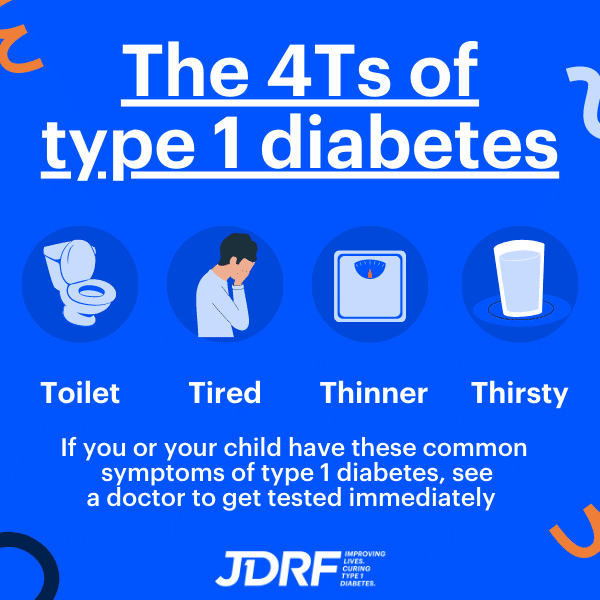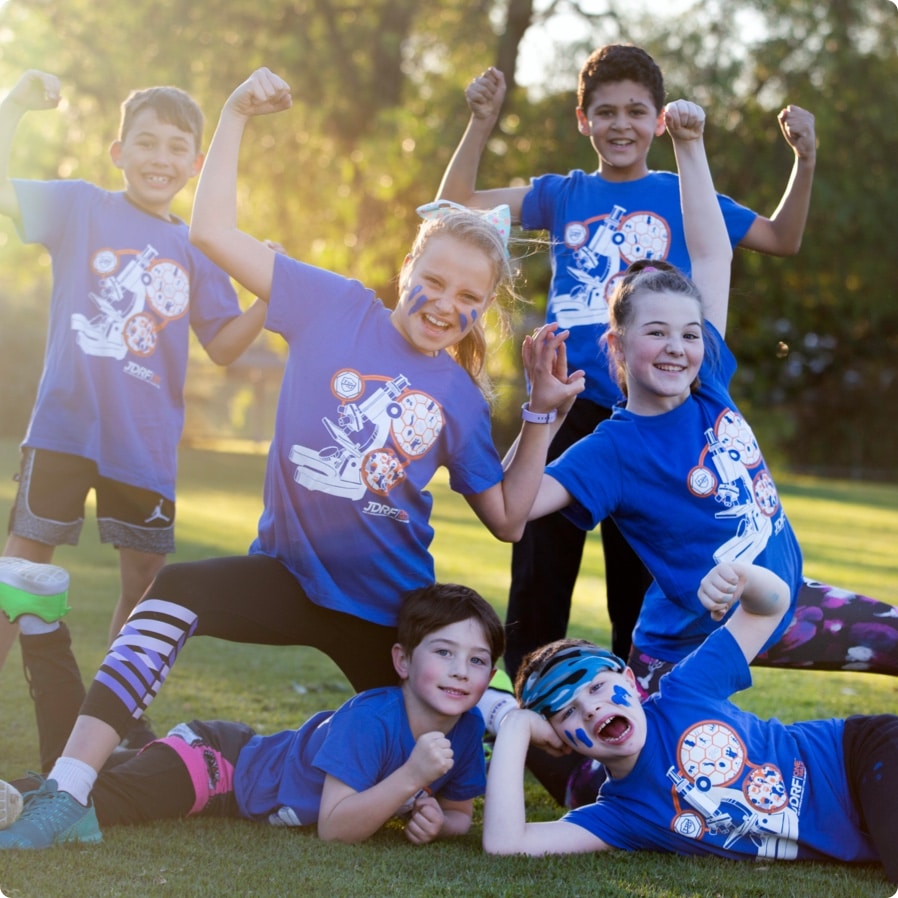Type 1 diabetes symptoms

What are the symptoms of type 1 diabetes?
Running to the loo a lot. Being super thirsty. Feeling run-down. If you don’t know what you’re looking for, it’s easy to ignore or overlook the symptoms of type 1 diabetes (T1D). However, given the condition can come on suddenly and potentially become very serious very quickly, it’s worth knowing what to look for in adults and children.
Here’s a rundown of the different symptoms, how they might look and feel, and when you should seek medical assistance.
Early signs of type 1 diabetes
Type 1 diabetes develops when the pancreas stops producing insulin. It can become serious as your blood glucose levels shoot up to dangerously high levels.
If this happens, there’s little or no insulin circulating in your body to ‘unlock’ the cells and give you energy, so your body will jump into overdrive to get rid of the excess glucose. One of the most common ways your body might do this is by trying to pee it out (frequent trips to the loo can be a sign that your kidneys are attempting to expel excess sugar in the blood). There are other signs, too.
Here’s our checklist of common type 1 diabetes symptoms to look out for:
- needing to urinate a lot
- feeling dehydrated and thirsty
- feeling tired and weak
- unexplained weight loss
- increased hunger (because you can’t get energy from the food you are eating)
- slow healing cuts or sores
- yeast infections.
If you’re ticking one or more of these boxes, seek medical attention.
It’s also worth knowing that after all these symptoms and getting a T1D diagnosis, you can suddenly become asymptomatic. This is known as the ‘honeymoon phase’ – where suddenly your symptoms go away and the pancreas starts producing insulin again. This can last a few months to a year after your diagnosis.
Hyperglycaemia
Hyperglycaemia is the medical term for high blood glucose levels, and it’s often what happens prior to being diagnosed with type 1 diabetes. If you’ve got hyperglycaemia, you’ll probably have some or all of those symptoms we mentioned above.
Once you’ve been diagnosed with T1D, hyperglycaemia can happen due to things like illness, missing a dose of insulin, eating too many carbs, not exercising enough or taking other medications not related to diabetes. But you’ll want to avoid it as much as possible, and try to keep your blood glucose levels within the healthy range set for you by your endocrinologist or healthcare team, because high blood glucose levels can turn into diabetic ketoacidosis (see below).
Untreated hyperglycaemia can also lead to serious health issues down the track.
Hypoglycaemia
Often shortened to ‘hypo’, hypoglycaemia happens when blood glucose levels drop too low (usually meaning less than 4mmol/L). It’s often related to diabetes treatment, but it can occur due to other medications and conditions (even in people who don’t have type 1 diabetes).
If you’re having a hypo, you can feel weak, shaky or sweaty, or find it hard to think straight. It can happen if you accidentally inject too much insulin, or if you’ve been too active or had less carbs with a meal than you thought. You can remedy the situation by checking your blood glucose levels and eating or drinking a carb-rich food to bring your levels back to normal (fast-acting carbohydrates such as jellybeans or 150ml of normal soft drink can help). Asking someone to help you if you’re unable to do this yourself is key.
Diabetic ketoacidosis (DKA)
Diabetic ketoacidosis can be a serious complication to hyperglycaemia. It occurs when your blood glucose levels remain too high for a long time, and there’s not enough insulin in your system to break the glucose down for energy. If you have undiagnosed type 1 diabetes, it can also be the point at which you seek help – simply because you’ll be so unwell.
If you develop DKA, your body starts burning fat stores. This creates ketones, which can be toxic in large amounts.
Along with needing to pee a lot and being thirsty, other DKA symptoms may include having fruity-smelling breath, flu-like symptoms, experiencing stomach pain or throwing up. In severe and emergency cases, you may also notice laboured or rapid breathing, known as Kussmaul breathing.
If you suspect you or a loved one has developed DKA, get medical help ASAP.
Symptoms of type 1 diabetes in children
The signs for type 1 diabetes are similar as those for adults, but health professionals suggest parents look for four main signs in children:
- Toilet – they’re peeing a lot
- Thirsty – they’re drinking way more than usual
- Tired – they don’t have their usual amount of energy
- Thinner – they’ve got unexplained weight loss.
If you suspect type 1 diabetes, get medical help immediately.
When to seek medical help
If your child has been urinating a lot and has had increased thirst for over a week, book in to see your GP as soon as possible. If your child loses consciousness, call an ambulance immediately.
Generally, for adults, it’s important to seek medical attention if you think you might have type 1 diabetes. It’s especially important if you have the symptoms above and are also fatigued, throwing up, can’t focus or feel confused, are having difficulty breathing, and have fruity-smelling breath.
Type 1 diabetes can quickly become a medical emergency, whether or not you’re diagnosed, so always check out your symptoms and get help.
Want more info on type 1 diabetes and how to manage it? Check out our other articles and resources below:
Sources
- Diabetes fact sheet (Royal Children’s Hospital)
- Honeymoon phase (JDRF US)
- Hyperglycaemia (Mayo Clinic)
- Hyperglycemia and diabetes (Johns Hopkins)
- Hypoglycaemia (Mayo Clinic)
- Hypoglycaemia and type 1 diabetes (JDRF Aus)
- Symptoms of type 1 diabetes (JDRF US)
- What to do in diabetic emergencies (Medical News Today)

I’m interested in hearing more about…
